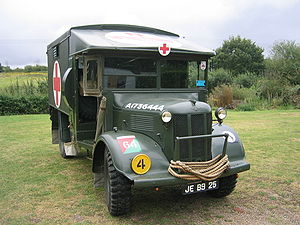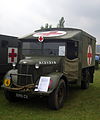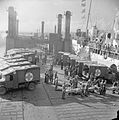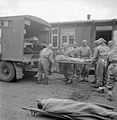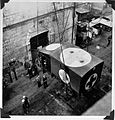
The Austin Motor Company Limited was an English manufacturer of motor vehicles, founded in 1905 by Herbert Austin in Longbridge. In 1952 it was merged with Morris Motors Limited in the new holding company British Motor Corporation (BMC) Limited, keeping its separate identity. The marque Austin was used until 1987. The trademark is currently owned by the Chinese firm SAIC Motor, after being transferred from bankrupt subsidiary Nanjing Automotive which had acquired it with MG Rover Group in July 2005.

The Volvo PV800 Series is a taxicab manufactured by Volvo from 1938 until 1958. The Sow series dominated the Swedish taxicab market during the 1940s and 1950s.

The Austin Champ was a military and civilian jeep-like vehicle made by the Austin Motor Company in the 1950s. The army version was officially known as "Truck, 1/4 ton, CT, 4×4, Cargo & FFW, Austin Mk.1" however the civilian name "Champ" was universally, if unofficially, applied to it. The majority of Champs produced went to the British Army.

The AEC Matador was a heavy 4×4 truck and medium artillery tractor built by the Associated Equipment Company for British and Commonwealth forces during World War II. AEC had already built a 4×2 lorry, also known as the Matador.

The LDV Pilot is a panel van that was produced by LDV Limited from 1996 until 2005, and closely based on preceding models dating back to the 1974 Leyland Sherpa.

The Austin Armoured Car was a British armoured car produced during the First World War. The vehicle is best known for its employment by the Imperial Russian Army in the First World War and by different forces in the Russian Civil War.

The LDV Convoy is a light commercial van that was manufactured by LDV Limited between 1996 and 2006.

A chassis cab, also called a cab chassis or half truck, is a type of vehicle construction, often found in medium duty truck commercial vehicles.

The Ford Thames 400E is a commercial vehicle that was made by Ford UK and introduced in 1957. Production of the range continued until September 1965, by which time a total of 187,000 had been built. Publicity for the model included hiring the Cy Laurie band to make the promotional film short 'Band Wagon', in 1958, preserved in the 'Ford Film and Video Collection' at the National Motor Museum, Beaulieu

The Land Rover Series I, II, and III, or simply the Land-Rover are compact British off-road vehicles, produced by the Rover Company since 1948, and later by British Leyland. Though inspired by the World War II jeep, the Land Rover immediately distinguished itself from all other cars. From launch, it was the first mass-produced civilian four-wheel drive car with doors, and an available hard roof. Contrary to conventional car and truck chassis, it used a sturdier fully box-welded frame. Furthermore, due to post-war steel shortage, and aluminium surplus, Land Rovers received non-rusting aluminium alloy bodies, favouring their longevity. In 1992, Land Rover claimed that 70% of all the vehicles they had built were still in use.

The URO VAMTAC is a Spanish four-wheel drive military vehicle manufactured by UROVESA. Externally it is similar in appearance and design to the Humvee of the United States Military due to similar requirements. More than 2,000 of the vehicles have been delivered to the Spanish Armed Forces. Several other countries operate the VAMTAC as well, and it has seen service most recently in Afghanistan and Syria. The vehicle comes in three models, named I3, S3 and ST5, and has several configurations.

Canadian Military Pattern (CMP) trucks were mutually coherent ranges of military trucks, made in large numbers, in several classes and numerous versions, by Canada's branches of the U.S. 'Big Three' auto-makers during World War II, compliant to British Army specifications, primarily intended for use in the armies of the British Commonwealth allies, but also serving in other units of the British Empire.

The history of the ambulance begins in ancient times, with the use of carts to transport patients. Ambulances were first used for emergency transport in 1487 by the Spanish forces during the siege of Málaga by the Catholic monarchs against the Emirate of Granada, and civilian variants were put into operation in the 1830s. Advances in technology throughout the 19th and 20th centuries led to the modern self-powered ambulance.

The UAZ-452 is a family of four wheel drive off-road vans and light trucks with body-on-frame construction and cab over engine design, built by the Ulyanovsk Automobile Plant (UAZ) since 1965. Since 1985, the vans received updates: more modern engines and internationally compliant lighting, as well as new model numbers, UAZ-3741 for the standard van, while (crew-cab) trucks mostly starting with UAZ-3303, often with one or two extra digits specifying the version. From 1997, bigger UAZ-33036 truck variants with a 25 cm (10 in) longer wheelbase, and taller soft-top roof bows and drop-sides were added.

The Dodge WC-54, Ambulance, 3⁄4-ton, 4 x 4,, was the main military ambulance variant of the prolific Dodge WC series of light 4×4 trucks, developed during World War II. Built from 1942 until 1945, they served as the U.S. Army's main dedicated ambulance, with many also serving in the Korean War, in the U.S. Army Medical Corps, some used as late as 1953; and others serving as late as the 1960s in the armies of some European countries.

The Dodge WC series is a prolific range of light 4WD and medium 6WD military utility trucks, produced by Chrysler under the Dodge and Fargo marques during World War II. Together with the 1⁄4-ton jeeps produced by Willys and Ford, the Dodge 1⁄2‑ton G-505 and 3⁄4‑ton G-502 trucks made up nearly all of the light 4WD trucks supplied to the U.S. military in WWII – with Dodge contributing some 337,500 4WD units.

The New York City Fire Department Bureau of Emergency Medical Services is a division of the New York City Fire Department (FDNY) in charge of emergency medical services for New York City. It was established on March 17, 1996, following the merger of the FDNY and New York City Health and Hospitals Corporation's emergency medical services division. FDNY EMS provides coverage of all five boroughs of New York City with ambulances and a variety of specialized response vehicles.

The original Škoda Superb is a full size luxury car that was made by the Czechoslovak car manufacturer ASAP, later AZNP from 1934 to 1949. It was the company's first car with a V8 engine and all-wheel drive.

American Ambulance, Great Britain (AAGB) was a humanitarian organisation founded in 1940 by a group of Americans living in London for the purpose of providing emergency vehicles and ambulance crews to the United Kingdom during World War II. The idea for the service came from Gilbert H. Carr during a meeting of The American Society in London shortly after the Dunkirk evacuation.
